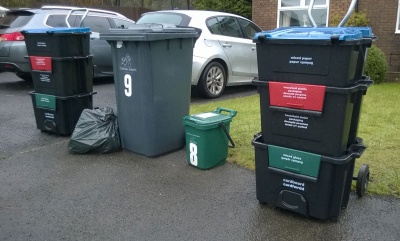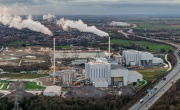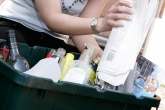Wales moves towards 58 per cent target
 Welsh local authorities (LAs) have recorded an average municipal waste recycling rate of 57 per cent in the 12 months to September 2015, six months before they must meet a government target of 58 per cent.
Welsh local authorities (LAs) have recorded an average municipal waste recycling rate of 57 per cent in the 12 months to September 2015, six months before they must meet a government target of 58 per cent.
Provisional data for LA municipal waste reuse, recycling and composting rate was released yesterday (18 February) covering up to September 2015, which showed LAs across Wales recycling an average of 57 per cent, up from the 55 per cent the previous year.
However, the amount of waste generated in the latest reporting period, July to September 2015, saw an increase of 411,000 tonnes on the same period in 2014, a rise of two per cent.
Targets
As part of its ‘Towards Zero Waste’ strategy, the Welsh Government has set a series of incremental statutory recycling targets (SRTs), culminating in a 70 per cent goal for 2024/25. At the end of this reporting year (March 31), a goal of 58 per cent has been set.
According to the provisional figures, only eight of the 22 Welsh LAs have already hit the target, with three more one percentage point away on 57 per cent and a further three on 56.
Rhondda Cynon Taff (59 per cent) is one of the LAs to have already hit the target, despite recording a rate of 48 per cent in September 2014. Using funding of £952,000 from the Welsh Government’s Collaborative Change Programme to improve recycling infrastructure and a partnership with the metal recycling campaign MetalMatters, the LA has risen from having the worst municipal recycling rate to reporting the joint-fifth highest rate in the recycling table. Changes to Cardiff’s waste collections have also seen the Welsh capital jump from 49 per cent to 56 per cent in a year.
In total, 14 of the 22 LAs increased their reuse, recycling and composting rate in the period from July to September 2015, compared to the same period in 2014, with the largest improvements coming in Carmarthenshire (nine percentage points) and Rhondda Cynon Taf (eight percentage points).
Faced with the increasing targets, which carry financial penalties for those that miss them, many Welsh LAs are considering less frequent residual waste collections to try and drive recycling tonnages up. Conwy is currently considering switching to monthly bin collection, while Anglesey last month agreed to move to a three-weekly system. Gwynedd, Powys and Blaenau Gwent have already started three-weekly collections, while Bridgend and Flintshire are both currently considering a three-weekly change.
Waste generation
The total amount of local authority municipal waste generated in Wales increased, with the tonnage rising by two per cent, from 403.8 to 411.4 thousand tonnes, compared to the same quarter of 2014.
Only eight of the LAs reported a decrease in total municipal waste generation during the July-September period.
Taking only residual waste into account, the amount of waste generated per person rose to 52 kilogrammes (kg) over the three months, one kg higher than the previous year.
Ceredigion, the county containing the towns of Cardigan and Aberystwyth, recorded an increase of 20 per cent in its total waste, which the government says is due to the inclusion of the tonnages of street sweepings. In terms of residual waste, the average Ceredigion resident’s waste rose by almost 50 per cent, from 41kg in July-September 2014 to 61kg in the same months in 2015.
Less than half of local authorities (9 of the 22) reported a decrease in residual household waste generated per person, compared with July to September 2014. The largest decrease was in Powys (down 15 per cent), followed by Merthyr Tydfil (down by 12 per cent).
Figures for each Welsh local authority can be found on the Welsh Government’s website.





